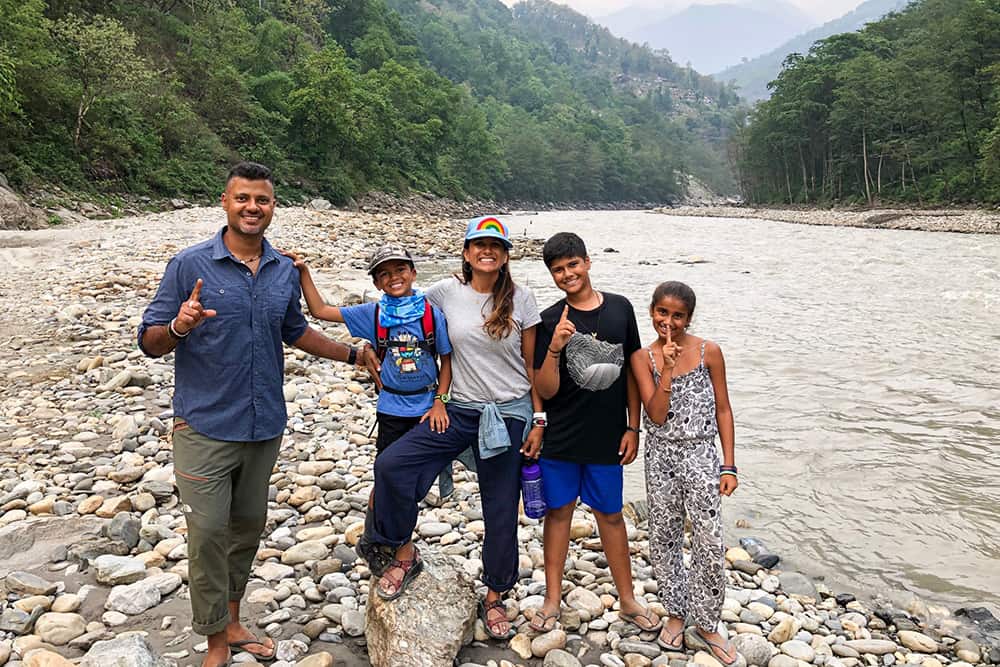
5 Distance Learning Tips From A Globetrotting, Homeschooling Mom Of 3
Written by Aila Malik
Photography by Photo Courtesy of Aila Malik
With the summer coming to a close and remote school on the horizon for most Americans, anxiety about how best to educate our children from home is at an all-time high. Sometimes the best tips and tricks, of course, come directly from other parents, which is why Aila Malik is sharing her unique take right here. The multi-tasking mother of three is a lawyer by schooling, nonprofit executive by trade, and the author of the new children’s book Mommy, Am I American?. The first-generation Pakistani-American is also a lover of travel, and recently journeyed to over 41 countries in a single year with her family of 5 in tow, homeschooling along the way. Below, the master multi-tasking mama to Zayan, 13, Kenza, 10, and Kaysan, 8, shares her top 5 distance learning tips for the road ahead!
We are deep into a tunnel…a long tunnel with a very distant light! As we embrace the new school year, most of us find ourselves in a world of distance learning, akin to “homeschooling” without the full control of the curriculum. We now have to make family decisions about who will take care of the kid(s) and how we will make this happen. Some of us cannot afford childcare, others of us think our kids are older and can handle it, and still, many of us balance responsible reliance on our “village” of neighbors, family members, and friends, to help us attend to the needs of our kids while we work to put food on the table. Let’s call it for what it is…a total clusterf*ck.
Well, our family of five have done this before. In fact, pre-COVID, we traveled for a whole 54 weeks and homeschooled our 1st, 3rd, and 7th graders. We are not even close to perfect and we struggled quite a bit, but here are five tips—based on our practice/experience—that we ourselves will rely on though this next school year.
1. Define Education For Your Child In This Opportunity
Our children are each beautifully unique and each has the right to reach their full potential. We need to set high expectations because they deserve it, but we want to take stock of what is important to them. Take a moment to be intentional about what success looks like for you and your child. Is it academic advancement, love of learning, wellbeing, or some combination of all three? This clarity will help guide you to focus when it all feels overwhelming. Be sure to ask your child, if at least 6 years or older, what 1-3 goals do they want to work towards during the year? Whether it’s riding a bike, making a friend, or being “good at” something, knowing your child’s desired goals will help you understand his/her motivations for engagement in school when the going gets tough.
2. Create A Schedule That Reflects Your Values
For many of us, the school’s distance learning schedule has yet to be understood. Likely, our kids K-12 will carry a mixed schedule of set virtual class time, office hours, and assignments. If it is anything like the schedule we experienced last school year, we can expect that there will be unstructured time during the day.
When we homeschooled for our year of travel, we learned that the kids were generally picking up concepts much more quickly because we were doing one-on-one teaching and we were pleased to learn that most studies support a 2-hour academic dosage for continued learning and progression through K-6 grade levels. We also relied on the basic benchmark for expected periods of focus, which is calculated by multiplying the child’s age by 5 mins.
Now, here is the rub: many of us will enter this new schooling era while the adults in the home are still working. Absent continuous use of electronic devices, kids ages 5 and younger often need a dedicated adult to help them navigate their day and basic needs. School-aged children between the ages of 6-15 years can operate with different levels of independence, but need a loose structure to help them stay on task and progress through their day.
We put these thoughts and concepts together with our family values and created a suggested schedule (more like a checklist) for our kids to self-regulate while both me and my partner worked from home. There could be a choice about how each child arranged their schedules, so long as they eventually got it all done. For us, the kids couldn’t get on electronics until the rest of their responsibilities were met and not before 3 p.m.
Here is our tool for you to copy and make your own: Template Schedule and Ideas.
3. Offer Limited Choice To Encourage Voice
Making choices and decisions is a natural part of life and the more practice our children have, the easier time they will have with easing into independence…or so that is the thought! Our family chose to build limited choices into the daily schedule to create space for the kids to activate their voice and ownership over their day. For example, from a limited list of ideas, our kids decide what chores to do, the type of creative activity, what snack to eat, and when to do which activity. But all of this only works if you take the time to get organized in advance.
Regardless of how much you and your child want to lean into the school’s plan of distance learning or apply your own homeschooling rigor, the more organized you are, the more independence and seamlessness you can expect as you begin a loosely structured routine. Designate areas, drawers, and/or cabinets for their ease in finding the right supplies for their activities, worksheets, or snacks. It is easier to prompt and/or redirect than it is to have to go and “find” something for them to do on the fly!
4. Find New Ways To Reinforce Academic Concepts
The gift of being on the teaching team for your child is that you will quickly understand what they are learning. To the extent that you are able to internalize the concept, you can draw upon it casually in different circumstances to help reinforce their learning. For example, a child learning about fractions could refresh their memory when handing out slices of pizza to the family at dinner, or halving a recipe and baking dessert! On our travels, states of matter (i.e. liquid, solid, gas) came alive for our second grader when he could visit a thermal geyser and see all of the states of water in action. And the same learning could be cemented with a stove, frying pan, and a cube of ice!
5. This Is A Marathon Not A Sprint…Build Resilience And Be Gentle With Yourself
At the end of the day, we can choose to orient ourselves to our circumstances. We will all have tough and tougher days, but to the extent that we can also hold and see the slivers of opportunity that this difficult time brings, we will build our own resilience within ourselves and our littles.
Whether the goal is to survive or thrive, take each day as it comes. Each specific day, kid, moment, and activity will bring its own trials and opportunities for growth. The capacity to recognize our elasticity—to feel the stretch, but bounce back to try again—is the very tool they will need to navigate through life. Don’t forget to pay attention to small ways we (as adults) can meet our needs (i.e. deep breathing, gratitude practices, an extra 10 minutes in the bathroom all alone, etc), so we can model resilience for our own kids. Finally, nobody is perfect, so that can’t be the goal. Instead, we can set an intention to learn to “do” and “be” our best selves. Good luck!
For more on Aila Malik and her family’s life-enriching journey, head over to Franklin Street Globetrotters.
Share this story




